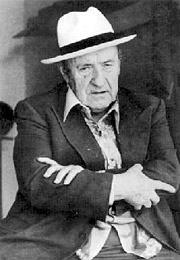


Bronze
32.4 × 23 × 24.5 cm. (12 3/4 × 9 1/16 × 9 5/8 in.)
base: 20.2 × 15 × 20 cm. (7 15/16 × 5 7/8 × 7 7/8 in.)
L.1988.62.72
Stamped on side of neck: Manzu NFMN
Nathan Chaikin. Henry Pearlman, New York, by 1974; Henry and Rose Pearlman Foundation, 1986.

Giacomo Manzu (1908-1991)
Giacomo Manzu was an Italian sculptor who worked outside of the academic tradition, forging a personal style of figurative sculpture that sought to convey universal meanings. The son of a shoemaker from Bergamo, he began work at the age of thirteen and learned the skills of gilding, stuccowork, and carving in wood, plaster, and stucco. Manzù was largely self-taught as an artist, his curiosity drawing him to both ancient Greek art and Michelangelo—works that he first encountered through reproductions. His discovery of Aristide Maillol’s work in a book at the age of fifteen proved revelatory, and by 1928 he had saved enough money to travel to Paris for a few days in order to see Maillol’s work in person. Manzù then returned to Italy, where he lived in Milan and began supporting himself as an artist through commissions for decorative sculptural work in churches while taking part in the Corrente movement, opposing official fascist culture. Religious subjects as well as figures drawn from everyday contemporary life would become his predominant subjects, and he sometimes combined elements of both to expressive effect. He also created paintings, drawings, and prints that reflected his interest in a spare naturalism.
Manzù had a wide impact through not only his individual works but also monumental commissions such as the bronze Doors of Death for St. Peter’s at the Vatican and projects for the Salzburg Cathedral and the United Nations headquarters in New York. He also had significant influence as a teacher; from 1943 to 1954 he was an instructor at the Accademia di Belle Arti di Brera in Milan, and from 1954 to 1966 he taught at the Summer Academy that Oskar Kokoschka had founded in Salzburg.